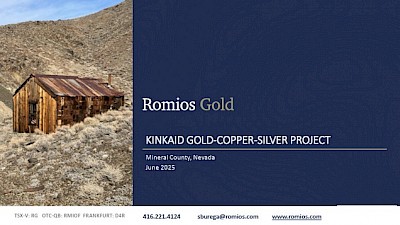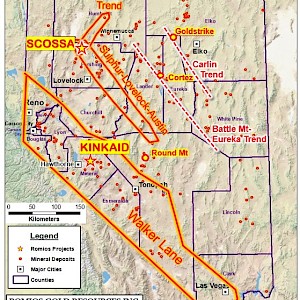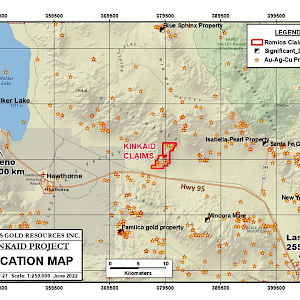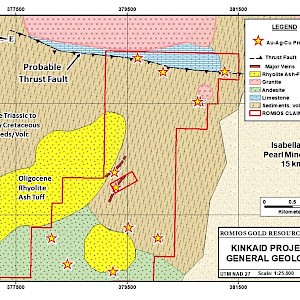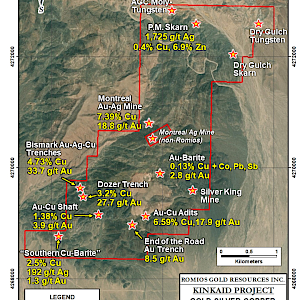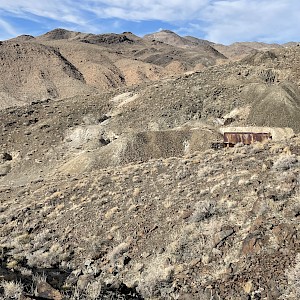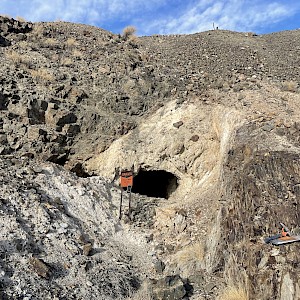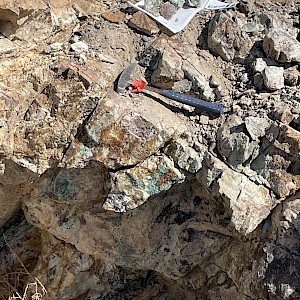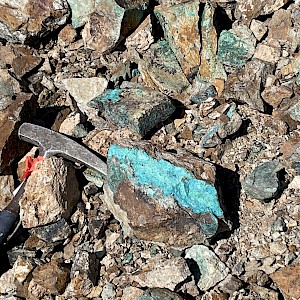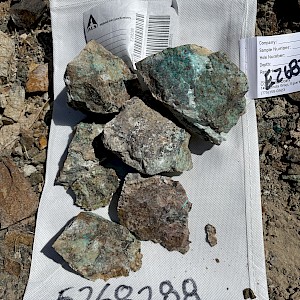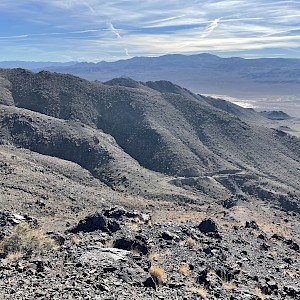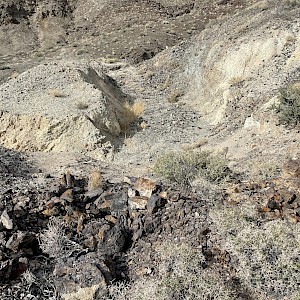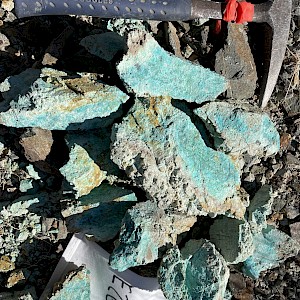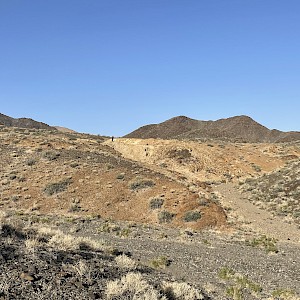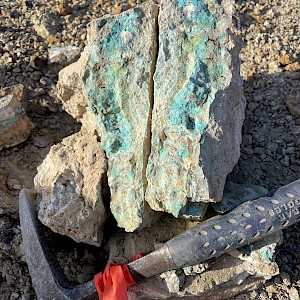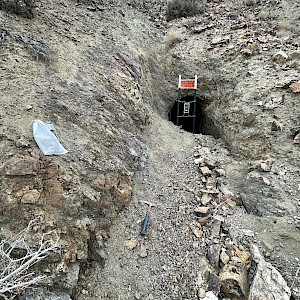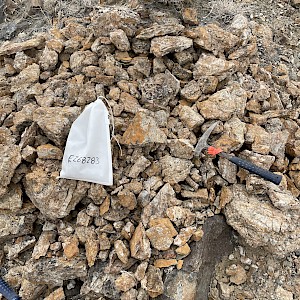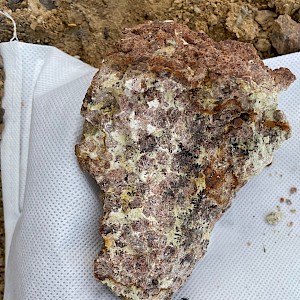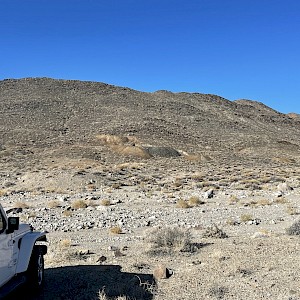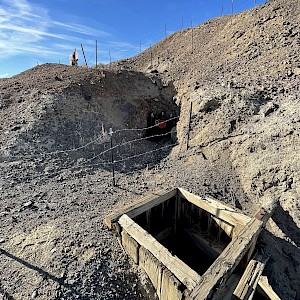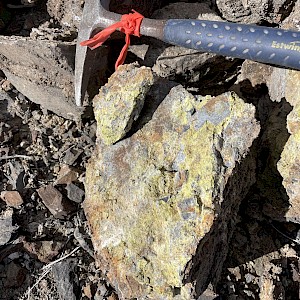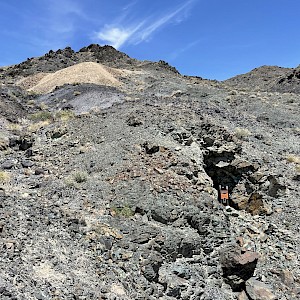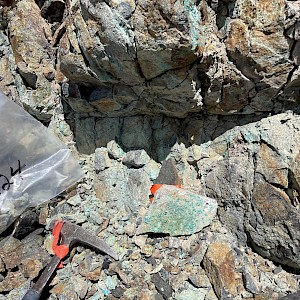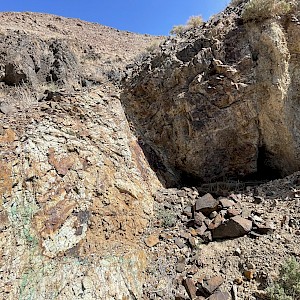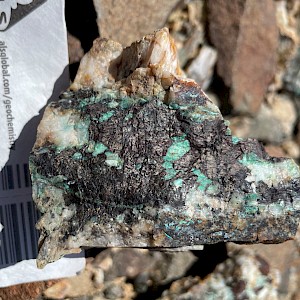Kinkaid Project
-
Overview
Property TypeAt least 13 historic mine workings and prospects across the property.
Two main types:
• Multiple epithermal Gold-Silver-Copper+/-Barite vein deposits on the southern and central claims, commonly high-grade.
• At least four skarn deposits on the northern claims, apparently mined for tungsten, gold, silver and molybdenum in the past.
Untested potential for a disseminated replacement style orebody on thrust faults beneath the two major Au-Ag vein deposits, similar to the nearby Isabella-Pearl mine.Exploration Stage:Early stage detailed geological mapping, satellite hyperspectral survey, drone magnetic survey. Expected to advance quickly to the drill stage.
LocationLocated in Mineral County Nevada, 18 km east of Hawthorne and a 2 hour drive from Reno. Largely road accessible.
-
Geology/Exploration
Highlights of Key Target Areas
GEOLOGY: The northern claims are underlain by a ~ N-S trending, Late Triassic to Early Cretaceous, metasediment and intermediate to felsic volcanic package of the Excelsior Formation. These strata are thought to be thrust northward over an east-west belt of recrystallised limestone which is exposed along the northern margin of the claims and intruded to the north by a large batholith and small plutons of Cretaceous granitic rocks. The Excelsior Formation is locally overlain by Tertiary rhyolite and quartz latite flows of substantial thickness and are likely intruded by feeder dykes to these flows. Several of the major mineral occurrences on the Kinkaid claims are developed within highly altered (clay, jarosite) fault zones along the margins of felsic dykes but it is uncertain at this point if these are the Tertiary feeder dykes.
The southern claims are depicted on the Nevada Bureau of Mines compilation map (Bulletin 58) as being underlain by a large Cretaceous diorite intrusion. Romios personnel have not observed any diorite on these claims to date and it appears more likely that the Excelsior Formation and the Tertiary felsic volcanics are the dominant rock types here.
MINERALIZATION:
EPITHERMAL GOLD-SILVER-COPPER QUARTZ VEINS: At least 9 historic Au-Ag-Cu mine workings are found on the southern Kinkaid claims and the nature of the mineralization is similar in most of them. Typically, these old mines exploited north-trending quartz veins with high concentrations of copper (chalcopyrite), frequently high gold grades, locally high silver values and locally abundant barite. Romios’ brief sampling efforts from 4-5 different sites returned 13 assays between 7 and 36 g/t Au, 15 assays between 1.5 and 7.39% Cu, and three silver assays between 188 and 212 g/t Ag from one site, the “Southern Barite-Copper-Silver” zone. The largest old mine on Romios’ claims, the 500 m long Montreal Au-Ag mine workings, and the adjacent Montreal Silver Mine (on a single claim held by an individual), both exploited mineralized quartz veins in highly altered zones up to 5-7 m wide adjacent to felsic dykes. Many of the other prospects occur around the periphery of two large masses of Tertiary felsic volcanics but it is unknown at this point if there is a genetic link to those flows or their feeder dykes. Numerous old trenches visible on satellite imagery remain to be mapped and sampled; every trench sampled to date has returned high-grade gold and/or copper values.
SKARN DEPOSITS: The northern Kinkaid claims cover a series of at least four skarn prospects apparently mined for a gold, tungsten, silver and molybdenum in the past. Romios has briefly examined 2 of these sites (Dry Gulch and PM) and located garnet skarn horizons at least 4 m wide and ≥ 200 m long developed from the local limestone beds. Numerous old underground workings and dumps are visible at these sites. The Dry Gulch skarn horizon trends NE away from the workings under cover towards an unmapped magnetic granite pluton evidenced by a large field of granitic boulders. The contact of the skarn horizon with this granite is expected to be a much more favourable site for Au-W mineralization than the location of the old workings. At the PM skarn, a 4-5 m wide garnet skarn was also noted for a strike length of about 200 m. Minor copper mineralization was noted locally in the skarn and a small mine dump of white quartz with 10-15% iron-carbonate filled fractures assayed 1,725 g/t Ag and 0.4% Cu with high mercury - 495 ppm Hg. A large mass of coarsely recrystallized limestone occurs immediately north of the PM prospect and is intruded by a granitic batholith along its northern margin. This geological setting provides an ideal setting for the development of additional mineralized skarns at the limestone-granite contact.
DISSEMINATED GOLD-SILVER THRUST FAULT TARGET: A potentially significant untested target exists on the northern and central claims where the north-trending sediment-volcanic package is believed to have been thrust northward over the coarsely crystalline limestone unit. The major Au-Ag veins in this area, the 350 m long Montreal Silver and 500 m long Montreal Gold-Silver mines, are developed alongside felsic dykes and are expected to extend to considerable depths, intersecting the thrust fault perhaps <1-200 m below surface. The intersection of these and other vein systems with the crystalline limestone at the thrust fault contact would provide an ideal setting for the deposition of broad zones of disseminated mineralization, a situation analogous to the Isabella-Pearl Mine 14 km to the east.
MONTREAL GOLD-SILVER MINE
This historic mine consists of a 500 m long series of old adits, small shafts, numerous pits and trenches, and mine waste dumps. Mineralized quartz veins occur within highly altered (clay, jarosite, etc.) faults up to 5-7 m wide developed within the local metasediments and metavolcanics at the contacts with a series of felsic dykes. Romios personnel have sampled a wide range of vein material types from the mine dumps and workings. Although some quartz samples have interesting epithermal textures, it is the samples with noticeable amounts of copper (chalcopyrite) mineralization that returned the significant gold grades: e.g. 18.8 g/t Au with 7.4% Cu, 24.4 g/t Au with 3.12% Cu. Silver values also correlate well with the highest copper-gold samples, ranging from 8 to 17 g/t Ag in the 3 highest grade samples.
Although the continuity and extent of the vein system is unknown at this point, the association of significant amounts of chalcopyrite with the highest-grade gold and silver values provides an opportunity to effectively define the gold-silver-copper rich sections of the veins through common geophysical methods such as Induced Polarization (IP). The possibility that this vein system intersects the postulated thrust fault at depth and may have spread out into the underlying crystalline limestone provides another target with considerable size potential.
SOUTHERN COPPER-BARITE-SILVER PROSPECT
Located in the SW corner of the Kinkaid claims, this site was excavated by previous operators who exposed several barite>quartz veins with abundant secondary copper mineralization (chrysocolla), high-grade silver values, and appreciable gold. A 20 cm wide barite vein in an old trench assayed 192 to 212 g/t Ag, 2.3 to 2.5% Cu and 0.95 to 1.3 g/t Au with 795-1,010 ppm antimony (Sb). Similar values were returned from a quartz dominant section of the vein(s). Based on the abundance of barite and antimony in these samples, it is believed that these veins are part of an epithermal mineralized system. The veins are located in the centre of a 250-300 m long x 50 m wide zone of light brown discoloration that may be indicative of an alteration halo around the vein system.
HILLSIDE MINE PROSPECT
One of many poorly documented or even unknown old workings on the Kinkaid property, this old mine site, named “Hillside” by Romios due to its location, consists of an upper shaft and a lower adit 50 m to the south (that apparently did not go far enough to reach the shaft). There is little quartz or carbonate vein material evident on the dump but a geologically spectacular coarse-grained epithermal calcite vein is exposed in the entrance to the adit at the base of the hill; a 15 cm chip sample across this vein assayed 3.86 g/t Au and 0.7% Cu. A rusty quartz vein from the dump around the upper shaft assayed 1.5 g/t Au and 1.4% Cu and several pieces of andesite and rhyolite stained with secondary copper minerals assayed 0.54 to 1.1% Cu and up to 0.8 g/t Au. A copper-stained shear zone near the adit strikes toward the shaft up the hill and a 1 m chip of this assayed 0.89% Cu and 1.78 g/t Au. Much of the local geology is obscured by the mine dump but it appears that the mineralization is developed within and adjacent to a rhyolite unit surrounded by andesites.
HILLSIDE TWO GOLD-LEAD-SILVER PROSPECT
This largely undocumented prospect consists of a 100 m long series of several adits driven into an area of light brown alteration on a hillside NE of the large rhyolite mass in the SE part of the claims. Examination of the dump material revealed a relatively small number of quartz vein pieces compared to some of the other sites in the area but these generally nondescript samples returned surprisingly high values for lead (3 of the 4 samples assayed between 0.48% and 0.7% Pb) with appreciable gold (up to 2.8 g/t Au) and sporadic highs in antimony (535 ppm Sb), and cobalt (706 ppm Co). Silver values range from 3.3 to 11.7 g/t Ag and the highest copper value was 1,310 ppm Cu.
The elevated lead values at this site are not uncommon in epithermal vein deposits nor is the high antimony result. The high cobalt value is unusual and its significance is still to be determined. The size of the colour anomaly around this apparent epithermal vein system is significant and suggests that this area was subjected to extensive hydrothermal alteration +/- mineralization and deserves to be mapped and sampled in detail, followed by geophysical/hyperspectral surveys and drilling if warranted by the results.
PM SKARN - SILVER PROSPECT
The PM Skarn prospect is one of 4 known skarns on the northern Kinkaid claims. It comprises a series of at least two adits, an inclined shaft and several small pits or trenches spread over an area 150 m wide. Reportedly mined for gold from quartz veins at one time, a field examination revealed a massive garnet skarn horizon approximately 4 m wide at the entrance to one adit and more outcrops of this unit for a strike length of about 200 m suggesting that these mine workings more likely targeted the skarns for gold and/or tungsten. A sample from a small stockpile of the typical quartz-iron carbonate vein material, with no obvious remnant sulphides, from a small pit near the entrance to a short adit assayed an impressive 1,725 g/t Ag (55 oz/t) as well as 0.4% Cu, 0.97% Pb, 6.87% Zn, 2,460 ppm antimony (Sb) and 495 ppm mercury (Hg). A sample of skarn outcrop west of the workings assayed 0.22% Cu. The high antimony and mercury values in the stockpile sample would suggest that it came from an epithermal silver-base metal vein overprinted on an area of skarn development. Detailed mapping combined with close spaced magnetic surveys should effectively define these overlapping targets and determine their size potential.
-
Press Releases
May 13, 2025Oct 8, 2024Jun 29, 2022Jun 14, 2022Mar 10, 2022

